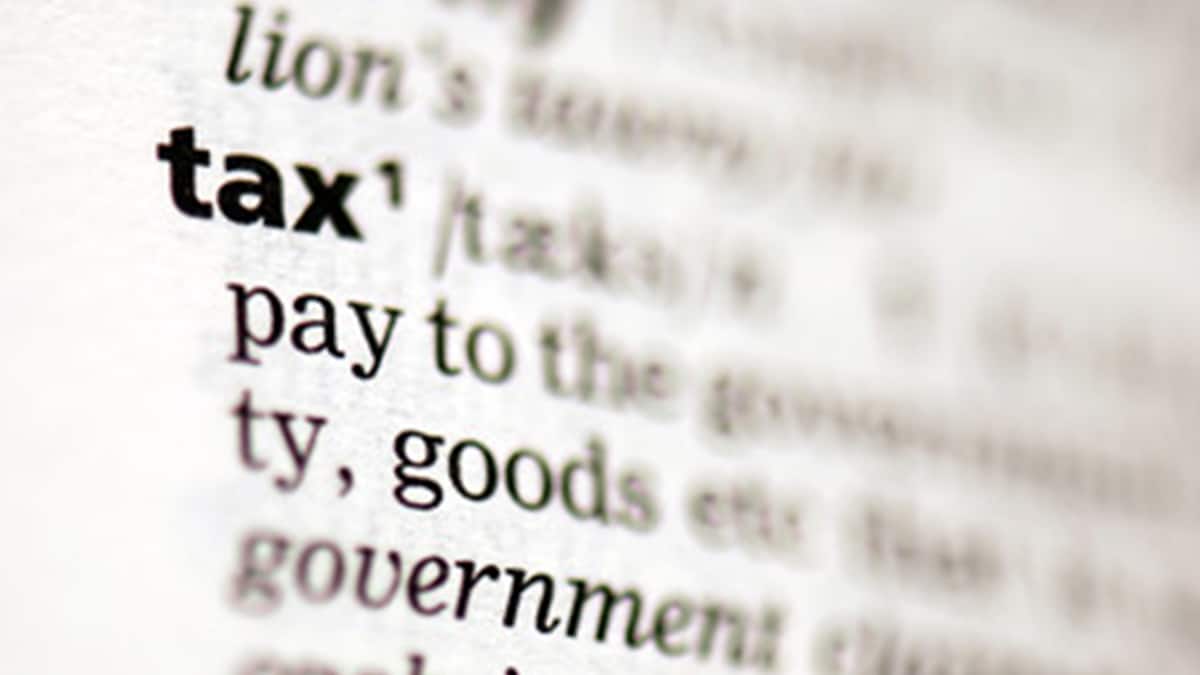In this guide
The Australian Tax Office (ATO) collects income tax from working Australians each financial year. In Australia, financial years run from 1 July to 30 June the following year, so we are currently in the 2025–26 financial year (1 July 2025 to 30 June 2026).
The income tax brackets and rates for Australian residents for both this financial year and the previous financial year are listed below.
Income tax rates for 2024–25 and 2025-26 (Australian residents)
| Income thresholds | Rate | Tax payable on this income |
|---|---|---|
| $0 – $18,200 | 0% | Nil |
| $18,201 – $45,000 | 16% | 16c for each $1 over $18,200 |
| $45,001 – $135,000 | 30% | $4,288 plus 30c for each $1 over $45,000 |
| $135,001 – $190,000 | 37% | $31,288 plus 37c for each $1 over $135,000 |
| $190,001 and over | 45% | $51,638 plus 45c for each $1 over $190,000 |
Note: The above amounts do not include Medicare Levy or the impact of tax offsets such as the Low Income Tax Offset (LITO).
Over the last few years both the Coalition and Labor governments have announced income tax cuts that have been applied in stages since 2018, and more are come into effect from 1 July 2026.
This financial year is one of the few in recent times where the income tax brackets or rates have not changed, although you may see a change in base income if your wage includes super, due to the increase in the Super Guarantee from 11.5% to 12%.
Continue reading to learn how Australian income tax is calculated including offsets, levies, surcharges and that may reduce or increase your income tax.

Free eBook
Retirement planning for beginners
Our easy-to-follow guide walks you through the fundamentals, giving you the confidence to start your own retirement plans.
"*" indicates required fields
- How income tax is calculated
- Tax offsets and deductions
- What is included in assessable income?
- What deductions are you allowed?
- What is taxable income?
- Income tax offsets, levies, and surcharges
- Low Income Tax Offset (LITO)
- Low and Middle Income Tax Offset (LMITO)
- Seniors and Pensioners Tax Offset (SAPTO)
- Medicare Levy
- Medicare Levy surcharge
- Lifetime Health Cover loading
- Private Health Insurance Offset
How income tax is calculated
The formula for calculating income tax payable is outlined below:
Assessable income minus Allowable deductions
equals
TAXABLE INCOME
apply tax rates
equals
GROSS TAX PAYABLE
minus tax offsets
equals
NET TAX PAYABLE
plus Medicare levy
minus tax credits and refundable offsets
equals
AMOUNT OWING OR REFUND
A common misunderstanding is that once your income hits a tax bracket, your whole income is taxed at that rate. Rather, once your income reaches a higher tax bracket, only the amount of income above that threshold is taxed at the higher rate.
For example, if you earn $50,000 in 2024–25 you are in the 30% tax bracket, which applies to income between $45,001 and $135,000. However, your whole income is not taxed at 32.5% – just the amount over $45,000 – which in this case is $5,000.
- The first $18,200 is tax free
- Then the amount earned between $18,201 and $45,000 is taxed at 16%. This equals $4,288 in tax.
- Then the amount earned between $45,001 and $50,000 is taxed at 30%. This equals $1,500 in tax.
- This totals $5,788 in tax – which amounts to an effective tax rate of approximately 13% on your total income of $50,000.
Note that this does not include offsets such as LITO, or the Medicare Levy. All of these are explained below.
What is the tax-free threshold?
The tax-free threshold refers to how much you can earn in a financial year before you are liable to pay tax. For Australian residents the tax-free threshold is currently $18,200, meaning the first $18,200 of your income is tax free, but you are taxed progressively on income above that amount. This is why Australia has what is called a progressive tax system.
Tax offsets and deductions
Tax offsets or credits reduce the tax payable on taxable income, but tax offsets should not be confused with deductions.
Deductions reduce a taxpayer’s assessable income while tax offsets directly reduce the amount of tax payable.
What is included in assessable income?
Your assessable income must be declared on your tax return each year. It includes any of the following:
Make your super work harder – for free

Get practical, independent guidance to help you grow your balance, save tax and make smarter super decisions with a free SuperGuide account.
Find out more1. Employment income
This includes any income you receive for full-time, part-time or casual work. Examples of employment income are:
- Salary, wages, commissions, bonuses, parental leave pay and payments from a work-related insurance scheme (such as income protection, sickness/accident payments or worker’s compensation).
- Any allowances that you may receive from your employer, such as car, travel, clothing, laundry, meal, working conditions or special duties/qualifications allowances.
- Any other income (like tips, awards or discounted employee shares).
- Any lump sum payments, such as when you leave a job and are paid out for any unused leave.
- Any reportable fringe benefits you received above $2,000 over a 12-month period, such as using a company car for private purposes or having your employer cover some of your private expenses as part of a salary packaging arrangement. Even though you need to declare fringe benefits, you don’t pay tax on it. Instead, it’s used to work out your eligibility for any government benefits.
2. Super pensions and annuities
If you’re receiving a pension from your super fund, it may have three different components:
- A taxed element (where your fund has already paid tax)
- An untaxed element (where tax still needs to be paid)
- A tax-free element (where no tax is payable).
Depending on your age, you may need to declare both the taxed and untaxed elements as income in the financial year you receive the payments, so that your overall tax obligation (or refund) can be determined by the ATO.
If you’re receiving regular income from an annuity, it will also usually have taxable and tax-free components. You’ll need to declare the taxable components.
3. Government payments
If you’re receiving government payments like the Age Pension or carer payments, they must be declared on your tax return. Even though some government payments are tax exempt, you must still declare them. That’s because they can affect your eligibility for other government benefits and tax offsets.
4. Investment income
This can include:
- Interest you receive from accounts you have with banks or other financial institutions
- Share dividends or returns from managed funds
- Rent from an investment property
- Capital gains you make on the sale of an asset.
5. Business, partnership and trust income
Any income you receive from running a business must be declared. If you’re a sole trader, you don’t need to lodge a separate business tax return.
If you’re in business in partnership with others, you must declare your share of the partnership’s income or loss as assessable income on your tax return.
If you’re a trustee in a trust, you must declare your share of the trust’s income in your tax return, even if it remained in the trust and you didn’t actually receive it.
6. Foreign income
If you’re an Australian resident for tax purposes, you must declare any foreign income you receive, even if it’s already been taxed overseas. The ATO uses a system of credits and exemptions to work out if Australian tax is payable on any foreign income you’ve earned.
Super knowledge is a super power

"*" indicates required fields
7. Crowdfunding income
If you’ve raised any income for a project or venture via crowdfunding, some of it may be taxable if you’re carrying on a business or other profit-making scheme.
Some of the seven types of assessable income listed above will be automatically provided to the ATO each year by your employer/s and financial institutions where you have money invested.
There are also other payments you might receive that aren’t included in your assessable income. Common examples include:
- Lump sum payments from insurance policies, such as for total and permanent disability
- The tax-free component of any eligible termination payments you receive when you leave an employer
- Genuine redundancy payments (up to certain limits based on your length of service)
- Child support or maintenance payments.
What deductions are you allowed?
Eligible deductions reduce your assessable income and therefore the amount of tax you have to pay. The most common deductions are:
1. Work-related expenses
These include:
- Vehicle and travel. You can claim vehicle and travel expenses if you personally incur them as part of carrying out your work duties and you aren’t reimbursed by your employer (for example, if you do deliveries using your own vehicle). You can also claim for any private costs of travelling between your employer’s different locations. However, you can’t claim the cost of travelling to and from work and your home.
- Clothing, laundry and dry-cleaning. You can claim for the cost of buying and cleaning work clothing provided the clothing falls into at least one of the following categories:
- It’s occupation-specific
- It’s protective
- It’s a compulsory uniform.
- Home office. If you regularly work from home, you can claim the cost for work-related home office expenses, including a portion of your home’s running expenses (like phone, electricity and internet costs) based on your dedicated work area, as well as any work-related equipment you buy.
- Phone and internet. If you’re paying for your own phone and internet connections and you use them for work, you can claim the percentage that relates to work use.
- Overtime meals. If you get an overtime meal allowance as part of your employment conditions (and which you must include in your assessable income), you can claim up to that amount as an expense if you’ve used it.
- Self-education. You can claim the cost of self-education expenses, such as costs associated with a course that leads to a formal qualification, provided they relate directly to your current employment. But you can’t claim repayments for any government assistance you receive to take a course (such as the Higher Education Loan Program).
- Tools and equipment. If you need to buy tools and other equipment to earn an income, you can claim a deduction for all or some of the cost, depending on the percentage of work-related and personal use.
- Other work-related expenses. This includes items like income protection insurance premiums (but not if you hold and pay for the insurance inside your super fund), union fees and any personal costs associated with attending work-related seminars or workshops.
2. The cost of managing your tax affairs
You can claim the cost of managing your tax affairs, including the cost of advice for preparing and lodging your tax return and business activity statements (BAS).
3. Gifts and donations
You can claim the cost of any charitable gifts or donations you make to ‘deductible gift recipients’. You can’t claim a donation if you received a personal benefit in exchange for your gift or donation, even if it’s a ticket to win a prize.
4. Interest, dividend and other investment income deductions
Expenses associated with earning assessable interest, dividends, rent or other investment income (like bank fees, interest on money borrowed to buy shares that have provided you with dividends, or investment management fees).
Make your super work harder – for free

Get practical, independent guidance to help you grow your balance, save tax and make smarter super decisions with a free SuperGuide account.
Find out more5. Personal super contributions
If you make a personal tax-deductible contribution to your super fund, up to the annual limit of $30,000, you can claim a tax deduction provided you complete an ATO form and send it to your super fund. Your super fund will tax your contribution at the concessional super rate of 15%, instead of your marginal tax rate.
When claiming any tax deduction, it’s important to keep records so that you can substantiate your claim if you’re ever audited by the ATO.
What is taxable income?
Your taxable income can be minimised by reducing your assessable income or increasing your deductions. For example, a negative gearing investment strategy relies on offsetting an investment loss (after deducting loan interest and other costs from your investment income) against other income. In this case, the investor is increasing their deductions to reduce their taxable income and tax payable.
Similarly, salary sacrificing some of your pre-tax income into super reduces your assessable income. Salary-sacrifice contributions are deducted at the time you are paid, which reduces your gross (assessable) income. This in turn indirectly reduces your taxable income. Moreover, the super contribution (up to an annual cap of $30,000 in 2024–25 and 2025-26) is generally taxed at a concessional rate of 15% on the way into your super fund, instead of your marginal tax rate.
Income tax offsets, levies and surcharges
Income tax offsets helps lower income earners who are Australian residents reduce their tax bill. Combined with the tax-free threshold of $18,200, LITO effectively allows you to earn up to $22,575 in 2025-26 before any income tax is payable.
Low Income Tax Offset (LITO)
The Low Income Tax Offset (LITO) is available to Australian residents with annual taxable income not more than $66,667.
The maximum offset of $700 applies to taxable incomes below $37,500 and gradually reduces to nil for incomes above $66,667.
Seniors and Pensioners Tax Offset (SAPTO)
As the name implies, SAPTO is a tax offset available to eligible Australian seniors and pensioners. In some cases, it can eliminate a recipient’s tax liability and their need to lodge a tax return.
Medicare Levy
Medicare gives Australian residents access to universal health care. It is partly funded by the Medicare Levy, which is 2% of your taxable income. You pay this levy in addition to the tax you pay on your taxable income.
Your employer will generally withhold enough tax to cover the levy, but the exact amount will be determined by the ATO when you submit your tax return. The Medicare Levy applies only to residents.
For 2024–25, you do not have to pay the Medicare Levy if your taxable income is less than $27,222, and the amount of Medicare Levy you pay will be reduced if your taxable income is less than $34,027. For families, the thresholds are $45,907 and $57,383 respectively.
If you are entitled to the Seniors and Pensioners Tax Offset (SAPTO) you do not have to pay the Medicare Levy if your taxable income is less than $43,020, and the amount of Medicare Levy you pay will be reduced if your taxable income is less than $53,775. For families eligible for SAPTO, the thresholds are $59,886 and $74,857 respectively.
Medicare Levy surcharge
An additional Medicare Levy surcharge (MLS) is payable if you earn above a certain income and don’t have adequate private health insurance. The MLS is calculated, depending on your surcharge income, at 1%, 1.25% or 1.5% of:
- Taxable income
- Total reportable fringe benefits
- Any amount on which family trust distribution tax has been paid
- Total net investment losses (e.g. negative gearing deductions)
- Reportable super contributions.
Medicare Levy surcharge income thresholds
The Medicare Levy surcharge (MLS) thresholds are as follows:
| Tiers for 2025–26 | Income threshold for individuals | Income threshold for families | Medicare levy surcharge |
|---|---|---|---|
| Tier 0 | Up to $101,000 | Up to $202,000 | 0% |
| Tier 1 | $101,001 – $118,000 | $202,001 – $236,000 | 1% |
| Tier 2 | $118,001 – $158,000 | $236,001 – $316,000 | 1.25% |
| Tier 3 | $158,001 and above | $316,001 and above | 1.50% |
Lifetime Health Cover loading
A person who does not have private health (hospital cover) insurance on their Lifetime Health Cover base day (usually 1 July following the 31st birthday) but who later in life decides to take out private hospital cover will pay a 2% Lifetime Health Cover (LHC) loading on top of their premium for every year they are aged over 30.
The LHC loading also applies if a person aged over 30 cancels their private health insurance and then later decides to take out private health insurance again. There is an exception, known as ‘days of absence’, which permits you to be without hospital cover for periods totalling 1,094 days (three years less one day) during their lifetime, without affecting their loading. This covers small gaps, such as switching from one fund to another.
However, if the total gap period exceeds 1,094 days, you will pay a 2% loading on rejoining private hospital cover. The loading increases by 2% for every year without cover after that. The LHC is removed after ten continuous years of private health insurance cover. The private health insurance rebate (see below) has not applied to the Lifetime Health Cover loading since 1 July 2013.
Private health insurance rebate
The private health insurance rebate is an amount the government contributes towards the cost of private health insurance premiums. The rebate can be claimed for premiums paid for a private health insurance policy that provides private patient hospital cover or combined hospital and general cover. The rebate is income tested, which means eligibility depends on your income.
The rates and thresholds for the private health insurance rebate that apply for the 2024–25 income year are listed in the table below. If a member of the family is over 65 then a rebate rate is also applied.
Offset entitlement by income threshold
| Tiers for 2025–26 | Singles | Couples |
|---|---|---|
| Tier 0 | Up to $97,000 | Up to $194,000 |
| Tier 1 | $97,001–$113,000 | $194,001–$226,000 |
| Tier 2 | $113,001–$151,000 | $226,001–$302,000 |
| Tier 3 | $151,001 or more | $302,001 or more |
Rate of Medicare Levy surcharge (all ages)
| Tier 0 | 0% |
| Tier 1 | 1.0% |
| Tier 2 | 1.25% |
| Tier 3 | 1.5% |
The Medicare Levy surcharge and private health insurance rebate income thresholds were paused at the 2014–15 amounts from 1 July 2015 and remained unchanged until 2022–23. Figures for 2023-24 are listed above.



Leave a Reply
You must be logged in to post a comment.